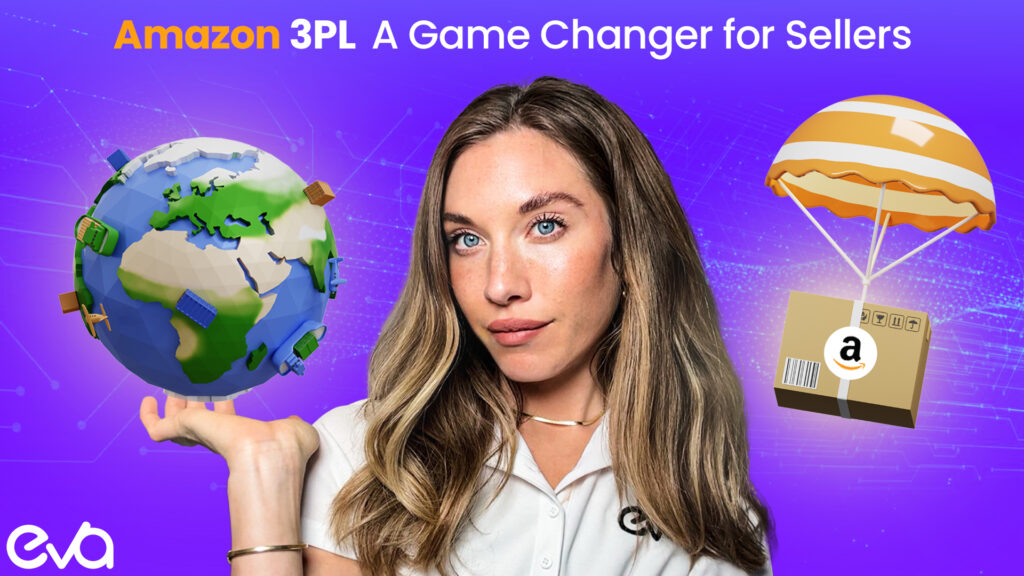Over the last few years – particularly since the pandemic – Amazon sellers have been forced to deal with a variety of disruptions to their Amazon fulfillment.
That’s why seminars on Amazon third-party logistics are often on the program at Amazon FBA and entrepreneurial meetups.
Third-party logistics (3PL) involves outsourcing logistics operations and supply chain management to specialized external companies.
An Amazon 3PL service manages, moves, and stores products on behalf of their clients without taking ownership of the goods themselves.
These providers offer Amazon logistics including transportation management, warehousing, inventory control, order fulfillment, and returns processing.
Many 3PLs also provide additional specialized services such as customs brokerage, supply chain consulting, technology integration, and custom packaging solutions.
From Amazon multi channel fulfillment to picking, packing and shipping, third party logistics gives an Amazon seller an important back-up plan when Amazon encounters their own problems.
Here’s what you need to know:
Table of Contents
- Streamlining Business Focus
- Maximizing Efficiency
- Competitive Advantages and Flexible Delivery Options
- Data-Driven Technology
- More Satisfied Customers with Third-Party Logistics!
- Reverse Logistics, What Is It?
- Using Third-Party Logistics for Omnichannel Sales
- 3 Most Important Areas that Third-Party Logistics Cover For You
- What Part Does Third-Party Logistics Play in eCommerce?
- How Can I Find a Good 3PL Company?
- How Does a 3PL Supply Chain Become Profitable Over Time?
- Conclusion
Streamlining Business Focus
Logistics management demands a significant amount of time and resources that could otherwise be invested in core business activities. By partnering with 3PL experts who specialize in shipping, warehousing, and inventory control, companies can redirect their focus toward product innovation and customer experience enhancement.
This delegation of authority allows internal teams to concentrate on strategic initiatives while ensuring reliable product delivery through professional logistics partners.

Discover How To Supercharge Your Profits From Amazon & Beyond
Tech – unlock more revenue, increase efficiency & maximize profitability with integrated AI solutions
Agency Services – our ex-Amazonian team provides key insights, expertise & handles everything for you from A-Z
3PL Fulfillment Solutions – real-time inventory management connected to Eva tech across Amazon marketplaces
Maximizing Efficiency
3PL providers leverage advanced technology and economies of scale to optimize delivery times, maintain optimal inventory levels, and enhance warehouse efficiency. This eliminates the need for businesses to invest in underutilized warehouse space or struggle with inventory constraints.
Modern 3PLs offer flexible storage solutions that scale with business needs, making it easier to maintain ideal stock levels while only paying for the space that’s used.
For example, the improved logistics of a back-up Amazon fulfillment service translates directly to better production reliability and customer satisfaction through consistent, timely deliveries.
Competitive Advantages and Flexible Delivery Options
With customers now expecting their Amazon orders to be delivered the same day, supplementary fulfillment services give businesses a competitive edge in the market.
Modern 3PLs have the infrastructure and expertise to execute the complex fulfillment strategies required in hyper-competitive 2025.
This flexibility allows businesses to rapidly adapt to changing market conditions and evolving customer expectations, ultimately driving higher satisfaction rates.
Data-Driven Technology
Advanced technology integration is at the heart of modern 3PL operations, enabling real-time tracking of shipments, materials, and inventory across the entire supply chain.
Rather than investing in expensive proprietary systems and specialized technical staff, an ecommerce business can leverage their 3PL partner’s sophisticated technology infrastructure.
This provides comprehensive visibility into delivery status and inventory levels, enabling more accurate production planning and faster problem resolution.
More Satisfied Customers with Third-Party Logistics!
Recent industry studies show that the vast majority of businesses report improved customer satisfaction after partnering with a 3PL provider.
Here’s how 3PLs drive these improvements:
1. Professional service
Modern consumers expect seamless shopping experiences across all channels – online, mobile, and in-store. Contemporary 3PLs enable this through sophisticated order management systems (OMS) that optimize inventory across multiple sources, facilitating services like buy online, pick up in-store (BOPIS) and ensuring consistent customer experiences across all touchpoints.
2. Increased order accuracy and visibility
In today’s market, customers demand real-time visibility into product availability and order status. Modern 3PLs employ advanced OMS solutions to provide accurate, up-to-the-minute inventory and tracking information. They implement methodologies to continuously improve order accuracy and service levels.
3. Cost-effective, quick deliveries
Contemporary 3PLs utilize strategically positioned fulfillment centers and advanced routing algorithms to optimize delivery speed while managing costs. Their established carrier networks and bulk shipping arrangements help secure competitive rates, enabling businesses to offer attractive shipping options to customers.
4. Individualization
Modern consumers increasingly demand personalized products and experiences. 3PLs now offer various value-added services like custom packaging, embroidery, engraving, and specialty gift wrapping. Their flexible infrastructure allows for last-minute customization while maintaining efficient delivery timelines.
5. Prompt service
A single negative review can change the course of a brand.
In an era where a poor experience can cost a customer relationship, 3PLs provide the scalability and expertise needed to maintain service quality even during peak seasons. Their comprehensive resources – including advanced technology, skilled labor, and strategically located facilities – ensure consistent service levels year-round.
Reverse Logistics, What Is It?
As e-commerce continues to grow, reverse logistics has become increasingly critical to the customer experience. This aspect of supply chain management goes beyond traditional forward logistics, handling everything that happens after a product reaches the customer. Modern reverse logistics encompasses:
- Product returns and exchanges
- Warranty claims
- Product recalls
- Refurbishment operations
- Sustainable packaging recovery
- End-of-life product management
- Seasonal inventory rotation
- Hazardous material handling
The Reverse Logistics Process
Customer Support
Modern reverse logistics begins with omnichannel customer support, including AI-powered chatbots, mobile apps, and traditional communication channels. This ensures customers have easy access to return or repair options 24/7.
Receiving the Product
Today’s return process is highly automated, with options including convenient drop-off locations, scheduled pickup services, and QR-code based returns. Many retailers now offer multiple return channels to accommodate various customer preferences.
Product Transportation
Reverse logistics utilizes sophisticated routing algorithms and real-time tracking systems to optimize return transportation. This may involve direct returns to manufacturers or routing through regional processing centers, utilizing the most cost-effective and environmentally conscious transportation methods.
Sorting and Processing
Advanced warehouse management systems and automation technology enable efficient sorting and processing of returned items. AI-powered systems can quickly assess product conditions and determine the most profitable recovery path.
Using Third-Party Logistics for Omnichannel Sales
Today’s retail landscape demands seamless integration between B2B and B2C operations. Rather than maintaining separate fulfillment streams, successful businesses leverage unified distribution strategies that optimize the “three I’s”: inventory, infrastructure, and information.
Differences between B2B and B2C
While B2B operations typically involve predictable, high-volume orders with specific delivery windows, B2C fulfillment must adapt to rapidly changing consumer demands and expectations. Modern 3PLs excel at managing both channels through integrated systems and flexible operations.
Using One 3PL to Handle Multiple Sales Channels at Once
Success in modern multi-channel fulfillment requires:
- Cloud-based inventory management systems
- Real-time visibility across all channels
- Automated order routing and processing
- Flexible fulfillment options
- Data-driven decision making
3 Most Important Areas that Third-Party Logistics Cover For You
In today’s complex e-commerce landscape, successful fulfillment operations rely on three critical pillars: inventory management, infrastructure optimization, and information systems integration.
These interconnected elements form the foundation of an effective 3PL partnership, enabling businesses to scale efficiently while maintaining high service levels.
Inventory
Modern 3PLs leverage sophisticated analytics and artificial intelligence to transform inventory management from a static process into a dynamic, responsive system.
By collecting and analyzing data from multiple sources – including historical sales patterns, seasonal trends, and real-time market conditions – 3PLs can optimize inventory levels across various channels while minimizing carrying costs.
This data-driven approach to inventory management has revolutionized how businesses handle stock, enabling them to respond quickly to changing market conditions while maintaining optimal service levels.
Through consolidated inventory management, modern 3PLs enable:
- Strategic buffer stock management across multiple locations
- Reduced safety stock requirements through sophisticated demand modeling
- Enhanced demand forecasting using machine learning algorithms
- Accelerated inventory turnover through optimized stock positioning
- Significantly lower carrying costs via dynamic inventory allocation
- Automated reordering based on real-time consumption patterns
Infrastructure
The physical backbone of modern 3PL operations has evolved dramatically with the integration of advanced automation and smart technology. Today’s 3PL facilities represent a quantum leap forward from traditional warehouses, incorporating cutting-edge systems that maximize efficiency while minimizing errors.
This technological evolution enables 3PLs to process orders faster, handle greater volumes, and maintain higher accuracy rates than ever before.
Contemporary 3PL facilities leverage:
- Smart conveyor systems with automatic sorting capabilities
- State-of-the-art automated storage and retrieval systems (AS/RS)
- AI-powered smart warehousing technology for optimal space utilization
- Fully integrated warehouse management systems (WMS) with real-time updates
- Flexible fulfillment workflows adaptable to changing business needs
- Strategic network optimization using advanced routing algorithms
- Robotic process automation for repetitive tasks
Information
In the digital age, information management has become as crucial as physical logistics. Modern 3PL solutions have transformed into comprehensive information ecosystems that provide unprecedented visibility and control over the entire supply chain.
By integrating various data sources and applying advanced analytics, these systems enable businesses to make informed decisions quickly and respond proactively to potential issues.
Today’s sophisticated 3PL information systems deliver:
- Detailed cost analysis and optimization tools
- Comprehensive real-time visibility across all sales channels and locations
- Advanced predictive analytics for demand forecasting and risk management
- Customizable performance dashboards with actionable insights
- Automated reporting with configurable alerts and notifications
- Seamless integration with major e-commerce platforms and marketplaces
- Machine learning-powered optimization recommendations
- Real-time inventory allocation and rebalancing capabilities
What Part Does Third-Party Logistics Play in eCommerce?
In e-commerce today, 3PLs serve as strategic partners rather than simple service providers. As online retail continues to evolve at an unprecedented pace, 3PLs have become essential architects of success, helping businesses navigate complex fulfillment challenges while maintaining competitive advantages in a crowded marketplace.
The integration of advanced technology, automation, and data analytics has transformed 3PLs from basic warehouse operators into sophisticated solutions providers that can adapt and scale with your business needs. They enable:
- Sustainable operations
- Rapid market expansion
- Flexible fulfillment options
- Enhanced customer experience
- Competitive shipping rates
How Can I Find a Good 3PL Company?
Finding the right 3PL partner is a critical decision that can significantly impact your business’s growth trajectory and customer satisfaction levels.
As the e-commerce landscape becomes increasingly complex, your 3PL partner needs to demonstrate not only operational excellence but also technological sophistication and strategic thinking capabilities.
When selecting a 3PL partner, consider:
- Disaster recovery and business continuity planning
- Technology infrastructure and integration capabilities, including their ability to seamlessly connect with your existing systems
- Network coverage and scalability to support your current operations and future growth plans
- Industry expertise and references, particularly their experience with businesses similar to yours
- Performance metrics and SLAs that align with your business objectives and customer expectations
- Value-added services such as custom packaging, returns management, and inventory optimization
- Sustainability initiatives and environmental commitments that reflect modern consumer values
- Financial stability to ensure long-term partnership viability and continuous investment in capabilities
- Communication protocols and transparency in reporting and problem resolution
- Cultural alignment and shared vision for growth and innovation
How Does a 3PL Supply Chain Become Profitable Over Time?
The journey to profitability with a 3PL partner evolves as your partnership matures, transforming basic logistics outsourcing into strategic advantages that drive sustainable growth.
Through continuous refinement of processes and data-driven insights, modern 3PL relationships create value through both operational excellence and strategic alignment.
A strategic 3PL partnership drives profitability through:
- Cost optimization through automation and network efficiency
- Reduced operational costs through economies of scale and resource optimization
- Improved inventory management using advanced analytics and forecasting
- Enhanced customer satisfaction from reliable fulfillment
- Scalable infrastructure that grows without capital investment
- Data-driven optimization of operations
- Continuous improvement based on performance metrics
- Risk mitigation and compliance management
Conclusion
Third-party logistics has evolved from a simple outsourcing solution to a strategic imperative for Amazon sellers. Modern 3PL providers offer sophisticated technology, scalable infrastructure, and expertise that enable sellers to compete effectively in today’s dynamic marketplace.
By leveraging 3PL capabilities, sellers can focus on core competencies while delivering the seamless, efficient fulfillment experience that customers demand.
As e-commerce continues to evolve, partnering with the right 3PL provider becomes increasingly crucial for sustainable growth and success in the Amazon ecosystem.








